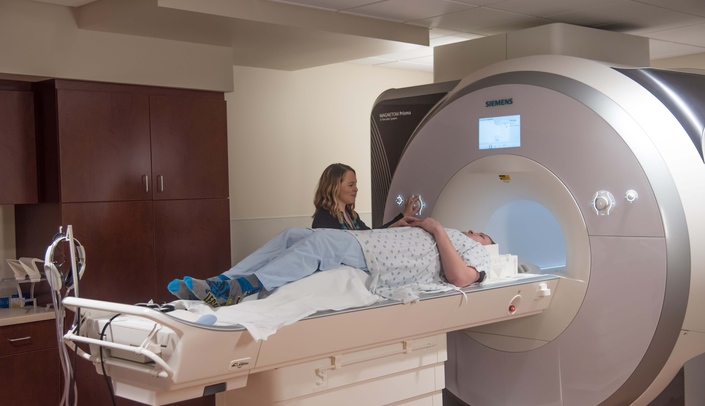When UNMC announced the addition of a research-dedicated magnetic resonance imaging (MRI) scanner earlier this month, it was truly a landmark event for the medical center.
This is no ordinary MRI. It is the most advanced MRI in Nebraska, providing the highest resolution imaging available while cutting the time the subject has to be in the MRI in half.
This MRI represents a major advance for UNMC’s research enterprise. Having such a state-of-the-art MRI dedicated to research will allow UNMC investigators to compete with their peers at elite research institutions in the country, with the potential to bring in millions of more dollars in research funding and make major contributions to a variety of research fields. It has been a missing element in our research infrastructure that will now allow a number of programs to take their research to the next level.
I’m happy to report the College of Medicine played a key role in making this happen. The college paid $3 million of the total $4 million cost to purchase the unit and install it. The remaining $1 million came from the Great Plains IDeA-Clinical and Translational Research award through the Institutional Development Award (IDeA) program and the NIH's National Institute of General Medical Studies that was awarded to UNMC in 2016.
Dr. Matt Rizzo, chair of neurological sciences, is the principal investigator on this nearly $20 million research grant which supports clinical and translational research among a collaboration of nine institutions in four states – Nebraska, North Dakota, South Dakota and Kansas.
The unit, which was installed on Dec. 3, is located in the heart of the UNMC/Nebraska Medicine campus on the first floor of the Hixson-Lied Center, which connects the Clarkson and University hospital towers. Research studies using the MRI are already underway.
Initially, the research-dedicated MRI will be likely be used predominantly by UNMC researchers in neurological sciences, psychiatry, cardiology and neurosurgery. But, it also will be available for investigators who are part of the four-state collaborative grant, as well as any other researchers who can benefit from it.
The timing could not be better. With society aging, the prevalence of neurological problems will continue to grow. This is being recognized by the NIH and other funding agencies through increases in research funding for neurological disease research.
Using this technology, investigators will hopefully begin to unravel how diseases such as Alzheimer’s disease, Parkinson’s disease and multiple sclerosis cause aberrations in the brain that severely affect behavior and quality of life. Understanding how the brain functions normally and is then altered by disease is critical to developing new ways to prevent and treat neurological diseases. It could help us understand how cancers develop or move to the brain and determine which medications are most effective in treating certain neurological conditions.
In fiscal year 2018, UNMC researchers brought in a record $135.6 million in research funding. This was a significant increase of 15.8 percent from the $117 million recorded the previous year. Now, thanks to the research-dedicated MRI, those numbers should continue to grow as UNMC will be able to participate in national multicenter trials focused on brain research and other areas.
Many people were involved in getting the MRI to UNMC. I want to first salute Dr. Tony Wilson, who will serve as scientific director for the MRI, and Dr. Rizzo. Nebraska Medicine’s support also was critical in getting the MRI here, and locating it in a prime location will make it very convenient for researchers and study participants. Finally, I want to acknowledge two of UNMC’s key leaders in research – Dr. Jennifer Larsen, vice chancellor for research, and Dr. Howard Fox, associate dean for research in the College of Medicine.
As we look back on 2018, it was an eventful year for the College of Medicine. It started with the Department of Genetics, Cell Biology and Anatomy winning the 2018 University-wide Departmental Teaching Award, and it culminated with the addition of the MRI.
In between, we hired four new chairs – Dr. Merry Lindsey, cellular and integrative physiology, Dr. Anna Spagnoli, pediatrics, Dr. Ron Krueger, ophthalmology and visual sciences, and Dr. Aviva Abosch, neurosurgery, and a new leader, Dr. Al Fisher, for the geriatric program in internal medicine.
The dermatology department under the leadership of Dr. Ashley Wysong became a reality, and the first residents arrived in the new residency program in the department of physical medicine and rehabilitation, under the leadership of Dr. Sam Bierner and made possible by the ongoing collaboration with the Madonna Rehabilitation Hospital. In addition, the year saw the establishment of a Center of Excellence in Pancreatic Cancer.
As we embark on 2019, let me extend my best wishes to all of you for a successful year ahead and offer my thanks for all your hard work and dedication.
A message from the dean
- Written by Tom O'Connor
- Published Jan 21, 2019
